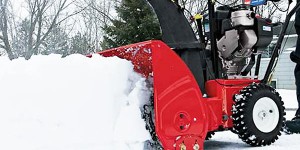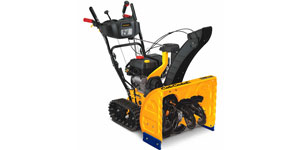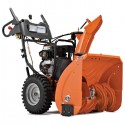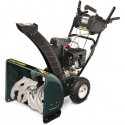Gas Two-Stage Snow Blower Reviews
These are the 10 best gas two-stage snow blowers based on product quality, customer satisfaction, and price:
 A gas two stage snow blower is a machine with a combustion engine and a two part snow clearing system that allows them to clear the heaviest snow fall in the most efficient manner. These machines have an auger that does not make contact with the ground, which scoops up heavy snow fall and passes it on to another part, the impeller fan. The impeller fan then blows the snow up through the snow chute, where it is thrown anywhere from 25 to 50 feet away. These snow blowers are the biggest and most powerful walk behind snow blowers you can find, and they are designed to handle the toughest jobs and the heaviest snow fall.
A gas two stage snow blower is a machine with a combustion engine and a two part snow clearing system that allows them to clear the heaviest snow fall in the most efficient manner. These machines have an auger that does not make contact with the ground, which scoops up heavy snow fall and passes it on to another part, the impeller fan. The impeller fan then blows the snow up through the snow chute, where it is thrown anywhere from 25 to 50 feet away. These snow blowers are the biggest and most powerful walk behind snow blowers you can find, and they are designed to handle the toughest jobs and the heaviest snow fall.
Two stage gas snow blowers are particularly useful in areas where the ground is not paved. Because they do not make contact with the ground, there is no risk of picking up gravel, wood chips or other debris with the auger that could potentially either damage the impeller fan or present safety hazards if flung out of the snow chute. Because they do not make contact with the ground, the augers on two stage gas snow blowers will necessarily leave a thin layer of snow behind. For this reason they are not recommended if you are clearing a driveway or sidewalk that is paved, as you will have to either clear it a second time or put down rock salt to melt any remaining snow.
Gas two stage snow blowers have some of the most powerful engines available on snow blowers today, which allows them a number of advantages over single stage or electric snow blowers. Generally, the engines on gas two stage snow blowers have displacements of upwards of 200 cubic centimeters that are able to deliver powerful performance. As a result, the engines can support some of the widest snow clearances available today – clearances that are as much as 26 to 45 inches wide or more. This allows these snow blowers to clear large areas much more quickly and efficiently than smaller single stage models can, which makes them perfect for commercial use as well as keeping very large driveways clear of snow.
In addition, the massive engines on gas two stage snow blowers are able to support snow cut depths that are much higher than those on smaller machines – anywhere from 24 to 36 inches or more. This allows these machines to handle even the biggest snow storms that drop the heaviest snow fall, and makes them perfect for regions like the Northeastern United States, which are regularly hit by severe winter storms, or the Great Plains, which get their fair share of blizzards as well.
The only snow clearing machine that is more robust than a two stage gas powered snow blower is a snow plow mounted on a vehicle. Two stage snow blowers are the only walk behind snow clearing machines that offer the kind of robust power and high clearance ability that can keep a big driveway clear of heavy snow fall all winter long.
1. Gas Two-Stage Snow Blower Selection Criterias
1a. Engine
 The size and make of the snow blower’s engine is going to be one of the most important selection criteria. This is because every other aspect of the snow blower’s performance and ability hinges on how powerful and well made the engine is. The clearance width and snow cut depth, clearance capacity of the impeller fan and auger, distance the snow blower can throw snow, and whether the machine is self propelled or not all depend on how much power the engine is able to produce.
The size and make of the snow blower’s engine is going to be one of the most important selection criteria. This is because every other aspect of the snow blower’s performance and ability hinges on how powerful and well made the engine is. The clearance width and snow cut depth, clearance capacity of the impeller fan and auger, distance the snow blower can throw snow, and whether the machine is self propelled or not all depend on how much power the engine is able to produce.
A number of criteria determine the engine’s ability, and it is important to understand all of them. Engines – whether for a small snow blower or a monster truck – are generally discussed in terms of three criteria: displacement, torque, and horse power. Engines on two stage gas snow blowers can range in displacement size anywhere from 150 cubic centimeters all the way up to 280 or more. The displacement size is an excellent general measure of the amount of power an engine can produce: put simply, a bigger engine is usually more powerful. But because a number of manufacturers are developing engines that are able to produce more power in less space, it is not the sole criteria you should look at.
Torque is another important determinant of an engine’s ability to power your snow blower. Torque is a measure of the amount of rotational force the engine is supplying to the snow blower’s engine belt and subsequently to its auger. Torque is measured in units called foot-pounds, and as you would expect, engines with higher torque provide more power to the snow blower.
Horse power is the final criteria for an engine’s power, and it is probably the one that people are most familiar with. This measurement is a holdover from the days when combustion engines were compared with the towing ability of horses, but combustion engines quickly got much more powerful than teams of horses, so much so that these days it is common to hear of trucks with hundreds of horse power. In two stage gas snow blowers, horse power generally ranges from about 4 or 5 HP on the smaller models all the way up to 15 HP or more on heavy duty commercial models.
Finally, it is important to get to know different small engine manufacturers so that you can be certain you are getting a product from a reliable manufacturer. Some of the best in the business are Briggs & Stratton, Honda, and Kohler.
1b. Auger
 The auger is the piece of the two stage snow blower that initially scoops snow off the ground and passes it up to the impeller fan, which then throws it through the snow blower’s chute. There are a number of important things to keep in mind when you are researching a two stage snow blower’s auger. The first is the overall design and durability of the auger. Often, smaller and single stage snow blowers have plastic augers. While this may be fine for keeping a small deck clear of light snow fall, it is not going to be durable enough to handle big jobs under tough conditions.
The auger is the piece of the two stage snow blower that initially scoops snow off the ground and passes it up to the impeller fan, which then throws it through the snow blower’s chute. There are a number of important things to keep in mind when you are researching a two stage snow blower’s auger. The first is the overall design and durability of the auger. Often, smaller and single stage snow blowers have plastic augers. While this may be fine for keeping a small deck clear of light snow fall, it is not going to be durable enough to handle big jobs under tough conditions.
On a two stage snow blower, you absolutely want a tough steel auger. Preferably, you should look for an auger that is made of tempered or heat treated steel, and you are going to want one that is made from manufactured steel rather than stamped steel. Stamped steel is durable, but not as durable as manufactured steel, which means it will not be able to last quite as long as the more heavy duty material. Regardless of whether you intend to use your two stage snow blower on paved or unpaved ground, it is important to get the best, toughest auger material you can find, even if it means paying a little extra.
The next thing to look at in the auger is its width. One of the main reasons to purchase a two stage snow blower is because these machines have the kind of power that can support extra wide augers that can clear large areas in much fewer passes than smaller one stage snow blowers can. Auger widths on two stage gas snow blowers can range from two to nearly four feet wide.
This is the kind of clearance width that will allow you to tackle very big jobs quickly and efficiently. This is what makes them the preferred snow blowers for professional landscapers – who want to get as many jobs done as quickly as possible – as well as grounds keeping crews and municipal operations. A two stage snow blower with a four foot wide auger can clear an entire walkway in one pass, and clear a college quad quickly and efficiently. Just think about how quickly a big machine like this can clear your driveway.
Of course, it’s important to balance clearance width with maneuverability and ease of storage. If you do not have an enormous driveway, you may not need the biggest auger available.
1c. Snow Cut Depth
 Depending on what region of the United States you live in, you may get heavy snow fall rarely, occasionally, or several times over the course of the winter. Regions like the Atlantic States and Midwest typically get no more than six or eight inches of snow during a big snow storm, but may experience a blizzard every few years that dumps twelve inches or more. In regions like New England and Upstate New York, as well as the Great Plains, big snow storms are far more common, and it is almost a routine occurrence to experience several blizzards a year.
Depending on what region of the United States you live in, you may get heavy snow fall rarely, occasionally, or several times over the course of the winter. Regions like the Atlantic States and Midwest typically get no more than six or eight inches of snow during a big snow storm, but may experience a blizzard every few years that dumps twelve inches or more. In regions like New England and Upstate New York, as well as the Great Plains, big snow storms are far more common, and it is almost a routine occurrence to experience several blizzards a year.
If you live in one of these regions, you probably already understand the importance of snow cut depth and clearance capacity on a snow blower. Snow cut depth describes exactly what it sounds like – the total depth of snow that the snow blower can clear on a single pass. Two stage gas snow blowers, in a large part because of their big engines and large augers, can support much higher snow cut depths than smaller single stage snow blowers can. As a result, they are much better equipped to handle the kind of snow fall that certain regions of the United States and Canada experience.
Along with snow cut depth, clearance capacity describes the ability of a snow blower to clear a particular amount of snow per minute. Obviously, snow blowers with higher clearance capacity can handle much heavier snow fall more quickly and efficiently. They are also able to handle wetter, slushier snow more easily than machines with lower clearance capacity can.
But similarly to auger width, choosing the right snow cut depth and clearance capacity can be a tricky decision. While it can be great to have a snow cut depth that is over two feet high, leaving you always prepared to face the most inclement weather, if you do not regularly experience that kind of weather it may not be necessary. If you are routinely using a big, heavy two stage snow blower to clear six or eight inches of snow where a smaller two stage snow blower will do, you will find this is largely inefficient. And because these machines rely on gas to run them, using a two stage snow blower with a huge snow cut depth to clear light snow fall will end up wasting a lot of your money in the long run.
1d. Drive System
 The type of drive system a two stage gas snow blower is equipped with is going to go a long way to determining the quality of the overall snow clearing experience, and this is only more so the case if you are going to have to be clearing snow on uneven terrain or long, sloping driveways. When you are using a two stage gas snow blower with a big engine, wide auger and high snow cut depth, the machine is going to weigh a lot. Two stage gas snow blowers can weigh anywhere from 150 to more than 400 pounds. That is too heavy for most of us to maneuver without a drive system to help out. This is especially true if you are attempting to negotiate an unpaved driveway, especially if it is on the side of a hill.
The type of drive system a two stage gas snow blower is equipped with is going to go a long way to determining the quality of the overall snow clearing experience, and this is only more so the case if you are going to have to be clearing snow on uneven terrain or long, sloping driveways. When you are using a two stage gas snow blower with a big engine, wide auger and high snow cut depth, the machine is going to weigh a lot. Two stage gas snow blowers can weigh anywhere from 150 to more than 400 pounds. That is too heavy for most of us to maneuver without a drive system to help out. This is especially true if you are attempting to negotiate an unpaved driveway, especially if it is on the side of a hill.
On smaller, single stage snow blowers, the auger itself makes contact with the ground and it is usually the principal drive system. But on two stage snow blowers, the auger is not designed to touch the ground, which means that powering the drive system usually falls to the rear wheels. But there are a number of types of drive system, so the question is, which one is right for you? That depends on the terrain you are going to be clearing, the size and weight of the two stage gas snow blower you are going to be using to complete the job, and your own physical ability. Drive systems can differ in a number of aspects.
Rear wheel drives are very popular among two stage gas powered snow blowers for obvious reasons. In the first place, it is rather difficult to place a front wheel drive system around the auger. Secondly, a rear wheel drive system is going to be much better at pushing the two stage snow blower through the snow. Rear wheel drive systems are also much more adept at pushing big, heavy machines up hillsides.
Drive systems will have several speed options, for the most part. While I do not think it is particularly important to get the two stage snow blower with the most speed options, as you will typically find a single speed that works best for you, I do think it is important to find a drive system that has both forward and reverse options. This allows you to back the snow blower out of tight spaces, which will make maneuvering it around your property much easier.
1e. Price
 Finally, we come to the price. The price of a gas two stage snow blower can range from extremely affordable, small models to very expensive, commercial models. You will of course have to decide what kind of budget you are working with, but within that budget there are still a number of considerations to pay attention to. The first rule is that you get what you pay for. And the second rule, which directly contradicts the first rule, is that you don’t always get what you pay for. Confusing, I know. Let’s discuss what I mean by this.
Finally, we come to the price. The price of a gas two stage snow blower can range from extremely affordable, small models to very expensive, commercial models. You will of course have to decide what kind of budget you are working with, but within that budget there are still a number of considerations to pay attention to. The first rule is that you get what you pay for. And the second rule, which directly contradicts the first rule, is that you don’t always get what you pay for. Confusing, I know. Let’s discuss what I mean by this.
First: you get what you pay for. This is an age old piece of advice that along with caveat emptor (“let the buyer beware“) means that if a bargain seems too good to be true, it probably is for one reason or another. All too often, an appliance that is considerably cheaper up front is not going to be worth the apparent savings. This is because cheaper appliances are often made with less durable parts or poorly manufactured engines that will not hold up to tough use over the long term. As a result, you will either have to pour a lot of money into repairing and maintaining cheaper appliances or else buy a brand new one every couple of years. As a result, cheap products can end up costing a lot over the long run.
But on the other hand, you don’t always get what you pay for – and this is particularly true for gas powered yard and garden appliances. While it may be tempting to get the most expensive, biggest, most robust machine, you probably don’t need it. As I explained in an earlier section, if you just have a driveway to keep clear and do not live in a region that regularly gets heavy snow fall, a huge commercial grade two stage snow blower is only going to be a waste of money. Bigger and more expensive is not always better.
And finally, you should always be on the lookout for bargains. Occasionally, manufacturers will drastically reduce snow blower prices – especially during the spring and summer when sales are slow. If you do manage to find a high quality two stage snow blower for a below average price, I recommend looking at its Pros and Cons carefully and doing some comparison shopping to determine if it is worth more than the list price, and if it is (and if it’s right for you), snap it up.
2. Best Gas Two-Stage Snow Blower Reviews
Ariens ST24DLE 





The Ariens ST24DLE is one big snow blower – that much is obvious as soon as you get it out of its box. Before you even get the snow chute and handle attached – a process that takes just minutes using regular household tools – you can tell that this is a snow blower designed [...]
Ariens 920013 





The Ariens 920013 is the type of heavy duty snow blower that is going to be well equipped for just about any conditions you might have to subject it to. Because it has one of the widest clearances you can find on any two stage snow blower, you will be able to finish removing snow [...]
Snapper 1696001 





The Snapper 1696001 is the kind of heavy-duty two stage snow blower you need when winter is dropping record amounts of snow fall in your area. With the Snapper 1696001, you will be well prepared for serious snow fall. That’s because the Snapper 1696001 has one of the most powerful engines you can find on [...]
Power Smart DB7651A-28 





The Power Smart DB7651A-28 is a snow blower that has everything you need to take care of heavy snow fall quickly and efficiently. With one of the widest clearances you can find on any snow blower anywhere, it is going to be well equipped to deal with a big area in fewer passes – which [...]
Power Smart DB7651-26 





The Power Smart DB7651-26 has a mean-looking serrated steel auger that can grind right through the densest, most hard packed snow you can find without getting bogged down or worn out. And not only does it have a tougher auger, the Power Smart DB7651-26 is made of durable materials all over, so you never have [...]
These are the 10 best gas two-stage snow blowers based on product quality, customer satisfaction, and price:






